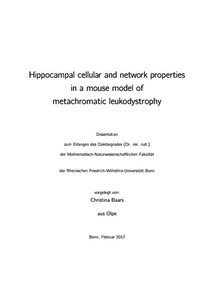Hippocampal cellular and network properties in a mouse model of metachromatic leukodystrophy

Hippocampal cellular and network properties in a mouse model of metachromatic leukodystrophy

| dc.contributor.advisor | Beck, Heinz | |
| dc.contributor.author | Baars, Christina | |
| dc.date.accessioned | 2020-04-24T11:23:02Z | |
| dc.date.available | 2020-04-24T11:23:02Z | |
| dc.date.issued | 30.11.2017 | |
| dc.identifier.uri | https://hdl.handle.net/20.500.11811/7305 | |
| dc.description.abstract | The human disease of metachromatic leukodystrophy (MLD) is caused by a single or multiple allelic mutations within the gene locus of arylsulfatase A (ASA). This protein is a lysosomal enzyme catalyzing the degradation of sulfatides. A loss in ASA enzyme activity is accompanied by sulfatide accumulation within lysosomal compartments and plasma membranes. Besides galactosyl-ceramide sulfatide is one of the major lipids in oligodendrocytic myelin sheets. In patients suffering MLD, a clear genotype-phenotype correlation can be observed.Affected patients show more or less signs of demyelinisation and a loss in cognitive abilities dependent on clinical subtype and therefore enzyme activity. To study neuronal cellular mechanisms and physiology in organisms with no ASA enzyme activity, a murine model for MLD has been established. Mice deficient in ASA accumulate sulfatides in glial cells, microglia, and neurons. Furthermore, they exhibit neuromotor deficits and mild behavioural disturbances. Invasive EEG recordings have revealed a marked cortical hyperexcitability, with episodes of spontaneous high-frequency (around 250 Hz) activity. Despite the description of these phenotypic abnormalities, a direct examination on neuronal excitability has been lacking. In a first subset of experiments we were able to show that even in young mice at an age of 8-12 weeks sulfatide accumulations could be found within hippocampal and adjacent areas. We have performed field potential, patch-clamp and sharp micrelectrode recordings in hippocampal slices to compare intrinsic, synaptic, and network properties of hippocampal principal cells from ASA-deficient mice and littermate controls. No apparent changes of passive or active membrane properties could be detected in CA1 or CA3 hippocampal principal cells of ASA-deficient mice. Despite the lack of changes in intrinsic excitability, we found evidence of altered network excitability. We recorded slow wave oscillations, so called sharp waves (SPW) in CA1 and CA3 hippocampal subfields, but found no differences in their incidence and amplitude between ASA-deficient mice and littermate controls in either subfield. However, the fraction of SPWs accompanied by high frequency oscillations, so called sharp wave ripple complexes (SPW-R), was significantly increased selectively in the CA3 pyramidal cell region of ASA-deficient mice. These results suggest that ASA deficiency causes a selectively increased propensity to generate high frequency network activity in CA3. Examination of the excitation-inhibition balance via feedback stimulation revealed no changes in ASA-deficient mice. Additionally experiments in CA3 pyramidal cells were performed to provide an idea of altered presynaptic properties measuring miniature postsynaptic currents. This revealed that presynapses are functionally unaffected in ASA-deficient mice. The reasons for an increase of high-frequency activity within CA3 subregion could not be identified via electrophysiological measurements of pyramidal cells within CA3 or CA1 region. Further investigations on interneuron activity and function have to be performed to clarify to what extent sulfatate accumulations in interneurons affect hippocampal network activity. | en |
| dc.language.iso | eng | |
| dc.rights | In Copyright | |
| dc.rights.uri | http://rightsstatements.org/vocab/InC/1.0/ | |
| dc.subject | seltene Erkrankung | |
| dc.subject | lysosomale Speicherkrankheit | |
| dc.subject | Pyramidenzelle | |
| dc.subject | Sulfatid | |
| dc.subject | neuronale Aktivität | |
| dc.subject | Epilepsie | |
| dc.subject | Mausmodell | |
| dc.subject | Elektrophysiologie | |
| dc.subject | Patch Clamp | |
| dc.subject | Feldpotential | |
| dc.subject | Aktionspotential | |
| dc.subject | Lysosom | |
| dc.subject | Gentherapie | |
| dc.subject | Arylsulfatase | |
| dc.subject | Sharp Wave | |
| dc.subject | action potential | |
| dc.subject | rare disease | |
| dc.subject | current | |
| dc.subject | lysosomal storage | |
| dc.subject.ddc | 500 Naturwissenschaften | |
| dc.subject.ddc | 570 Biowissenschaften, Biologie | |
| dc.subject.ddc | 610 Medizin, Gesundheit | |
| dc.title | Hippocampal cellular and network properties in a mouse model of metachromatic leukodystrophy | |
| dc.type | Dissertation oder Habilitation | |
| dc.publisher.name | Universitäts- und Landesbibliothek Bonn | |
| dc.publisher.location | Bonn | |
| dc.rights.accessRights | openAccess | |
| dc.identifier.urn | https://nbn-resolving.org/urn:nbn:de:hbz:5n-49115 | |
| ulbbn.pubtype | Erstveröffentlichung | |
| ulbbn.birthname | Albus | |
| ulbbnediss.affiliation.name | Rheinische Friedrich-Wilhelms-Universität Bonn | |
| ulbbnediss.affiliation.location | Bonn | |
| ulbbnediss.thesis.level | Dissertation | |
| ulbbnediss.dissID | 4911 | |
| ulbbnediss.date.accepted | 30.10.2017 | |
| ulbbnediss.institute | Medizinische Fakultät / Kliniken : Klinik für Epileptologie | |
| ulbbnediss.fakultaet | Mathematisch-Naturwissenschaftliche Fakultät | |
| dc.contributor.coReferee | Hofmann, Michael |
Dateien zu dieser Ressource
Das Dokument erscheint in:
-
E-Dissertationen (4397)




